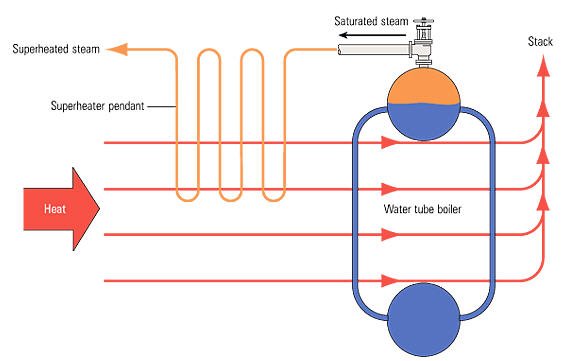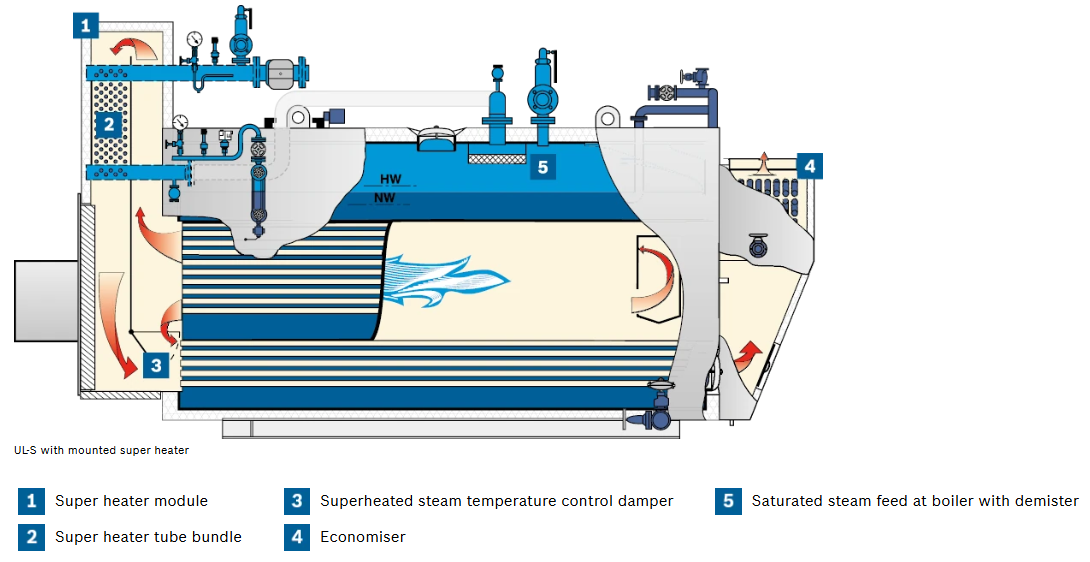In modern industrial production, industrial boilers are indispensable and important equipment, providing thermal power for many production processes. In the boiler system, there is a key component -- boiler superheater, its performance directly affects the operating efficiency and stability of the entire boiler system. Next, let us in-depth understanding of all aspects of the boiler superheater.
The boiler superheater is a specialized device that raises the temperature of the steam produced by the boiler and converts saturated steam into superheated steam. The saturated steam is at the boiling point temperature at the corresponding pressure, while the superheated steam is further heated to a temperature above its boiling point.
The primary function of a superheater is to raise the temperature of steam by using the heat of the combustion gases for secondary heating. This process offers a number of significant advantages.
In terms of energy transfer, superheated steam has a higher thermal energy than saturated steam, allowing for more efficient heat transfer in industrial applications. In the field of power generation, superheated steam is often used in steam turbines to generate electricity. Its higher temperature and energy content can significantly improve the efficiency of the turbine, thereby increasing the amount of electricity generated. In addition, superheated steam has a lower moisture content, making it ideal for steam processing systems that require high levels of steam dryness. By raising steam temperatures and improving steam performance, superheaters play a key role in improving the overall efficiency and performance of boiler systems.
A boiler superheater is essentially a coil and tube type heat exchanger. Its working process is to convert the saturated or wet steam produced by the boiler into dry or superheated steam through heat exchange. The converted superheated steam can be used to drive steam turbines to generate electricity, to power steam engines, or as an important part of other industrial processes such as steam reforming. Compared to ordinary boiler units, superheaters are key equipment for further improving steam quality. Most ordinary boilers produce steam that only reaches saturation temperature, while superheaters are optimized and upgraded on this basis.
Because superheated steam has a higher thermal energy, its use in steam power plants allows for more adequate energy conversion, thereby improving the efficiency of energy utilization throughout the plant.
The lower moisture content allows superheated steam to impact turbine blades with less erosion caused by water droplet impact, extending the service life of the turbine blades.
Because of the high thermal efficiency of superheated steam, less steam is required to meet the same heat demand, thereby reducing overall steam consumption.
Since superheated steam has less moisture, heat loss due to condensation is correspondingly reduced when it is transferred in boiler steam piping.
By removing moisture from the steam, the superheater effectively raises the temperature of saturated steam, providing higher quality steam for subsequent industrial applications.
The convective superheater is usually installed after the convection tube bundle, next to the high temperature flue gas. In this position, it enables the superheated steam to reach temperatures of up to 50°C. The flow of the high temperature flue gas transfers heat to the steam by means of convective heat transfer to superheat the steam.
The radiant superheater is installed in the radiant area of the combustion chamber. In high-pressure boilers, this type of superheater is capable of raising the temperature of steam up to 100°C. It relies on radiant heat transfer from the flame and high-temperature flue gas to transfer heat to the steam for further heating.
The independent combustion type superheater is installed outside the main boiler and has its own independent combustion system. However, their efficiency is usually lower than that of other types of superheaters, so they are generally less often chosen unless there is a special need for their use.

In the operation of equipment such as turbines, only dry steam is allowed. This is because any moisture in the steam may lead to reduced performance or corrosion of the equipment, which in turn shortens the average service life of the equipment. At this point, superheaters play an important role by converting low-quality steam into high-quality dry steam that meets the operational requirements of equipment such as turbines.
When steam needs to be transported over long distances, due to the inevitable loss of temperature during the transmission process, a superheater is required to heat the steam to a higher temperature to ensure that the steam still meets the requirements for use when it reaches its destination.
In steam engines, absolutely dry steam is required to prevent wear and tear of engine parts, and superheaters are able to provide dry steam to meet this requirement.
In water-tube boilers, where high-temperature gases are capable of supplying the temperatures required for the production of superheated steam, the superheater may be used as an additional part of the furnace area. In other cases, however, the relatively low temperature of the gas produced by the gas turbine may necessitate the use of a separate combustion superheater to meet the steam superheating requirement.

Changes in boiler operating conditions, such as adjustments in load levels, changes in fuel types, and fluctuations in combustion conditions, can have an effect on the superheater outlet steam temperature, especially the temperature of the steam in the boiler tubes. When the boiler load increases, the heat generated by combustion increases, which may lead to excessive steam temperature if not adjusted in time; and changes in the calorific value and composition of the fuel also affect the heat generated by combustion, which in turn affects the steam temperature.
In power station boilers, in order to stabilize the superheater outlet steam temperature at a specified value, the following methods are usually used. First, the direct use of water spray or surface desuperheater to regulate the steam temperature, when the steam temperature is too high, by spraying water or contact with the cooling surface to reduce the steam temperature; second, through the oscillating burner to change the furnace outlet flue gas temperature, thus indirectly regulating the superheater heat absorption, to achieve the purpose of controlling the steam temperature; third, the use of flue gas recirculation technology to regulate the superheater heat absorption, so as to keep the steam temperature stable.
The choice of superheater material is crucial, which is directly related to the durability and performance of the superheater under extreme temperature and pressure conditions. The main influencing factors include steam temperature, pressure and corrosion resistance. As the steam temperature rises, the material needs to have higher strength and creep resistance, in order to withstand greater thermal stress; working in a high-pressure environment, the material must have excellent pressure-bearing capacity; at the same time, due to the presence of combustion gases in the working environment of the superheater and impurities in the steam, the material also needs to have a good corrosion resistance, in order to ensure long-term stability of operation.
Based on the above influencing factors, in the manufacture of superheater, often use a variety of steel alloy materials. Carbon steel is commonly used for low-temperature superheaters, where it provides a good balance of strength, cost and weldability. Low alloy steels are suitable for medium temperature application scenarios and offer improved creep resistance and strength compared to carbon steel. For superheaters operating in high temperature and high pressure environments, high alloy steels such as T91 and T23 are required, which offer excellent creep resistance, high temperature strength and oxidation resistance. In some corrosive environments or where high purity vapors are handled, austenitic stainless steels such as TP304 and TP316 are used.
Boiler superheaters, as core components in industrial boiler systems, play an irreplaceable role in enhancing steam quality and improving system efficiency and performance. From its working principle, type, application, to performance adjustment and material selection, every aspect is closely related and crucial. In practice, the correct selection and rational use of boiler superheater can effectively improve the efficiency and stability of the entire industrial production process. With the continuous development of industrial technology, the boiler superheater will continue to progress in the direction of more efficient, energy-saving, durable, and is expected to play a greater role in the industrial field in the future.